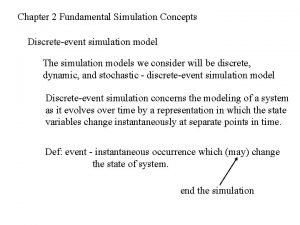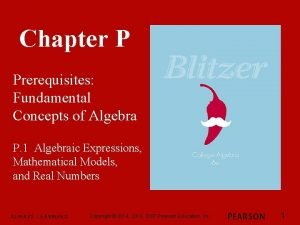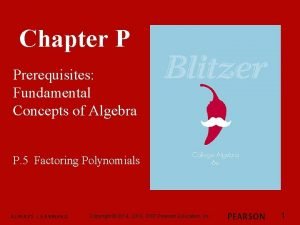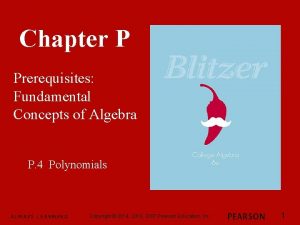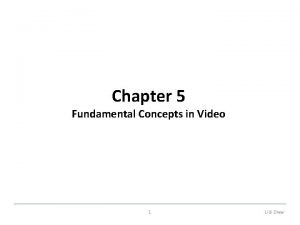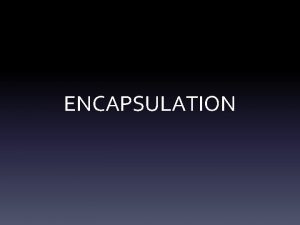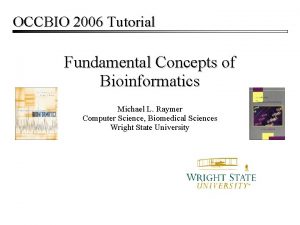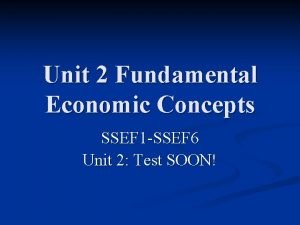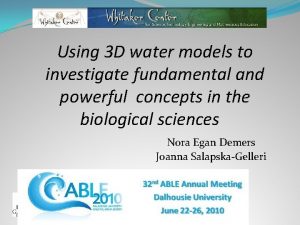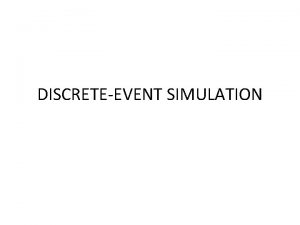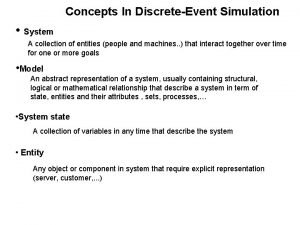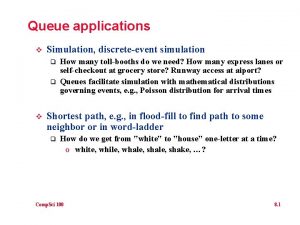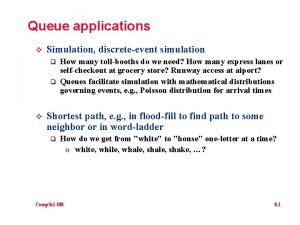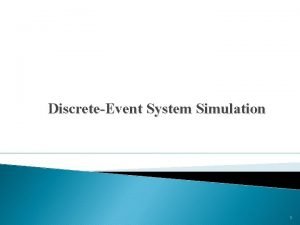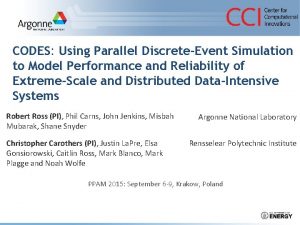Chapter 2 Fundamental Simulation Concepts Discreteevent simulation model










- Slides: 10

Chapter 2 Fundamental Simulation Concepts Discrete-event simulation model The simulation models we consider will be discrete, dynamic, and stochastic - discrete-event simulation model Discrete-event simulation concerns the modeling of a system as it evolves over time by a representation in which the state variables change instantaneously at separate points in time. Def: event - instantaneous occurrence which (may) change the state of system. end the simulation

Time-Advance Mechanisms Def: Simulation clock - The variable in a simulation model gives the current simulated time. The unit of time is never explicitly when a model is written in a general-purpose language. Simulated Time The time needed to run a simulation on the computer

Time-Advance Mechanisms Two principal approaches for advancing the simulation clock Next-Event Time Advance The simulation clock is initialized to zero and the times of future events are determined. The simulation clock is then advanced to the time of occurrence of the most imminent(first) of these future events. (Ex 1. 2, Law ) Fixed-Increment Time Advance

Components and Organization of a Discrete-Event Simulation Model System State - The collection of state variables necessary to describe the system at a particular time. Simulation Clock - A variable given the current value of simulation time. Event List - A list containing the next time when each type of event will occur. Statistical Counter - Variables used to storing statistical information about system performance.

Components and Organization of a Discrete-Event Simulation Model Initialization Routine - A subprogram to initialize the simulation model at time zero. Timing Routine - A subprogram that determine the next event from the event list and then advances the simulation clock to the time when that event is to occur. Event Routine - A subprogram that updates the system state when a particular type of event occurs (there is one event routine for each event type) Library Routine - A set of subprograms used to generate random observations from probability distributions that were determined as part of the simulation model.

Components and Organization of a Discrete-Event Simulation Model Report Generator - A subprogram that computes estimates (from the statistical counters) of the desired measures of performance and produces a report when the simulation ends (p. 20). Main Program - A subprogram that invokes the timing routine to determine the next event and then transfer control to the corresponding event routine to update the system state appropriately. The main program may also check for termination and invoke the report generator when the simulation is over.

Flow of control for the next-event time advance approach

What output performance measures you want to collect? • The total production • The average waiting time in queue (Tally) • The maximum time waiting in queue Service level guarantees to customer • The time-average number of parts waiting in the queue Allocating floor space • The maximum number of parts that were waiting in the queue

What output performance measures you want to collect? • The average and maximum flow time (cycle time) • The utilization of the machine

Some notes about simulation 1. Not optimization procedure The result is “Your cost will be c if you take action x” not “Your cost is minimized if you take action x” 2. Simulation Model : simplified model
 Fundamental simulation concepts
Fundamental simulation concepts Chapter p prerequisites: fundamental concepts of algebra
Chapter p prerequisites: fundamental concepts of algebra Chapter p prerequisites fundamental concepts of algebra
Chapter p prerequisites fundamental concepts of algebra Chapter p prerequisites fundamental concepts of algebra
Chapter p prerequisites fundamental concepts of algebra Chapter p prerequisites fundamental concepts of algebra
Chapter p prerequisites fundamental concepts of algebra Fundamental concepts of managerial economics
Fundamental concepts of managerial economics Sociolinguistics concept
Sociolinguistics concept Four fundamental oop concepts
Four fundamental oop concepts Fundamental concepts of bioinformatics
Fundamental concepts of bioinformatics Unit 1 review fundamental economic concepts answers
Unit 1 review fundamental economic concepts answers Fundamental and powerful concepts
Fundamental and powerful concepts
